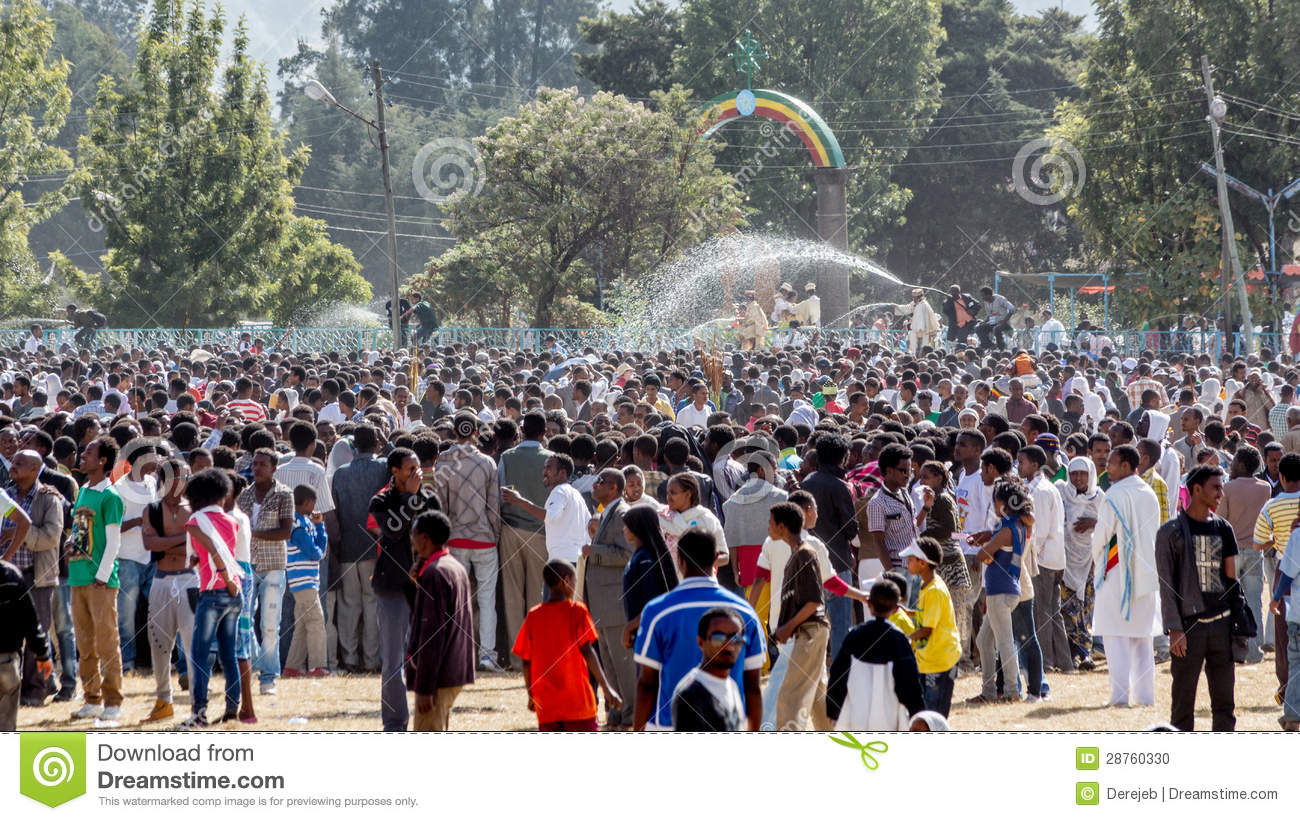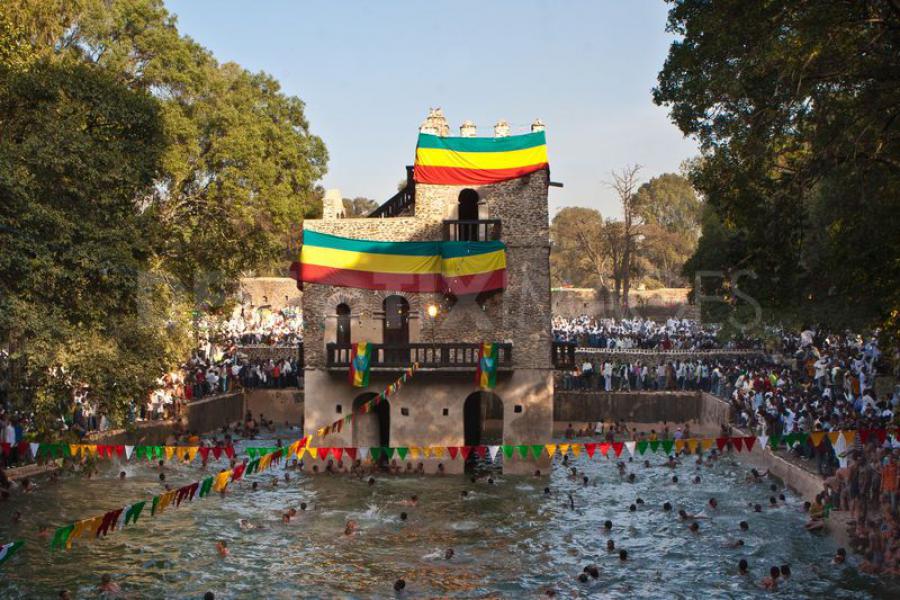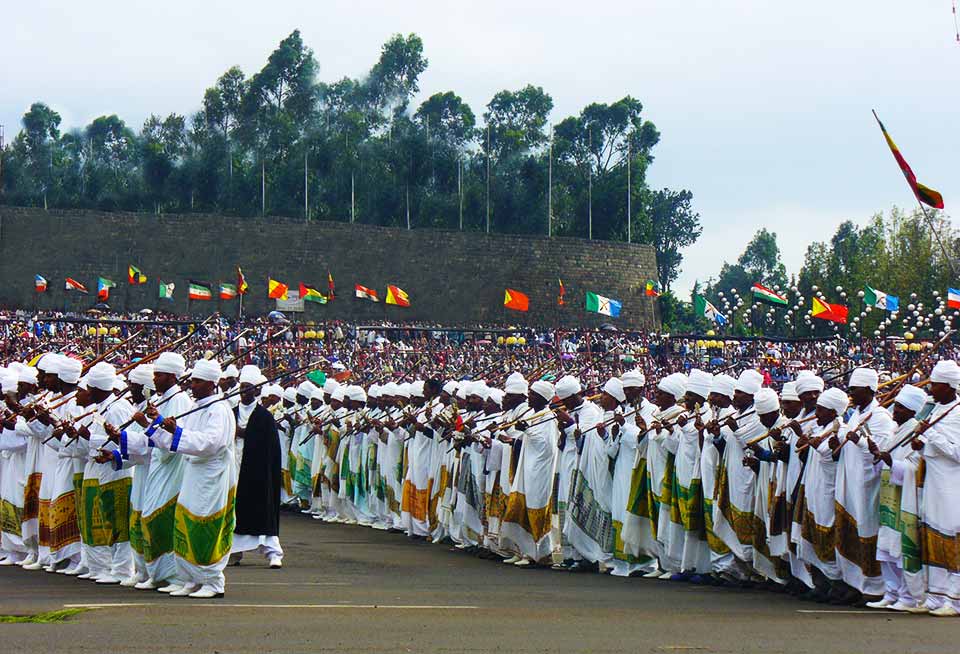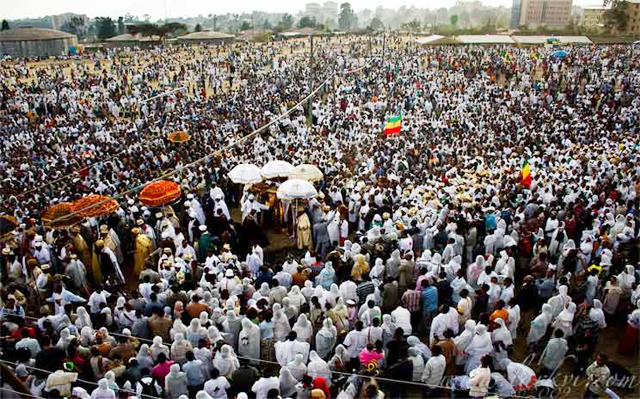The Festival of Timket
January 18, 2017
By Kassa Nigus
Baptismal pool in Jan – Meda, Addis Ababa

‘Timket’ is a Ge’ez word meaning “immersion in water” similar to the Baptism of Jesus Christ. The word also denotes epiphany which is driven from the Greek word epiphaneia meaning “appearance”. The annual Timket celebration is held across Ethiopia on Tir 11 E.C (January 19 G.C)
with processions of priests carrying replicas of the Ark of Covenant, locally known as ‘Tabot’, escorted by thousands of believers. The day is observed in commemoration of Christ’s baptism in the Jordan River. Timket is not only one of the major feasts of the Ethiopian church but it is also a public holiday when offices and schools across the country are closed.
The festive lasts two days, the 18th (the eve of Timket) and the 19th 0f January, even extending to a third day where there is Tabots dedicated to Archangel Michael whereby celebrated the feast of the miracle of Jesus at the wedding of Cana.
Though Timket is celebrated on January 19, the season, according to the church’s tradition, covers the period from the eve of the festival to the start of the three-day fast observed in commemoration of the fast the people of Nineveh observed to avert God’s wrath.
During the Timket season, the church praises the Lord reciting chants and readings pertaining to the Birth, Circumcision, and Baptism of Christ as well His miracle at a Wedding in Cana of Galilee. (Luke 2:21; John 2:1-11)
The Origin of Timket Festival in Ethiopia
As land of God, Ethiopia has been following the teachings of the apostles and started celebrating epiphany at the national level in 530 AD during the reign of Emperor Gebre Meskel. In 1140 AD, king and priest Lalibela made an amendment to the existing tradition of the Epiphany celebration by which he made a decree that urged all Arks of covenant (Tabots) to be carried to a river or pool together to bless the waters. (Megabe Mstir Welde Rufael Fetahi and Kesis Samuel Eshetu, 2014)
In 1426 AD, following a proposal from scholars, Emperor Zer’a Ya’ekob declared that the Tabots be taken to nearby pools on the eve (January 18) and stay the night there blessing the nation. In 1486 AD, Emperor Naod also made an order that the Tabots be escorted by the faithful in colorful processions. (Ibid.)
The Eve of Timket
Baptismal pool of Fasiledes in Gondar

The eve of Timket is known by the two major events: Ketera and Gehad. Following those traditions, the Tabots are taken to rivers and pools early afternoon on the eve of Timket, which is known as “Ketera” meaning ‘making a reservoir for the celebration’. Each Tabot is carried overhead by a high priest to the nearby body of water accompanied by thousands of church members chanting hymns. The celebration is also augmented by spiritual dancing (known as Shibsheba), drum beating, horn blowing, prayer stick waving and sistra rattling.
Alula Pankhurst (2010) state that the eve of Timket is known as Ketera, a reference to damming a stream to make a baptismal pool, known as Timkete Bahir. He recounted quoting from early literature that James Bruce, the 18th century Scottish traveler, describes how the streams are in Adwa was dammed for several days to reach a depth of four feet. In some cities pools were purpose – built, the most famous being Fasiledes’s pool at Gondar and the queen of Sheba’s at Aksum. The 16th century Portuguese writer Francisco Alvares describes how water was diverted at Emperor Lebne Dengil’s court through an intricate system of channels and pipes and filtered through cloth.
The celebrations begin with a procession leaving each church in the early afternoon after a service and a prayer which is known as Wazema have been performed as it has been done during other major church holidays.
Around 3 Pm, the chiming of church bells signals the appearance of the Tabot and excitement mounts among the awaiting crowds. The head priest emerges bearing the Tabot on his head secluded from public view by a velvet cloth embroidered with gold and silver. Other priests hold ceremonial umbrellas above the Tabot for adoration as well as to protect it from sun and rain. Women ululate, youths cheer, and crowds applaud to the rhythm of drum beat. The procession circles the church and sets off, preceded by Sunday school choirs. Priests carry swaying censors, deacons beat drums, and groups of youths sing and dance, while musicians blow trumpets and play string instruments. (Ibid.)
The festive procession is said to symbolize the journey of Jesus from Galilee to the River Jordan described in Mathew chapter three and has also been linked to Biblical scenes of David dancing around the Ark described in Samuel chapter six. On the journey more and more people join and onlookers fall to their knees in reverence, some kissing the ground, some rubbing their bodies with soil and grass from under the feet of priests carrying Tabots to ensure blessings. (Ibid)
The procession turns into a massive human river in which participants are swept along with the joyous tide. Once the Tabots are safely installed in their tents the service begins with the patriarch’s (head priest’s) benediction. Choirs form two parallel lines and perform their rhythmic swaying dances, moving towards each other and parting again raising and lowering their sistra in one hand and their prayer sticks in the other, to the beat of the drummer in the middle who gradually increases the tempo, finally reaching a frenzied climax. (Ibid)
The eve of Timket is also locally known as Gehad, meaning ‘manifestation’ in relation to the appearance of Jesus Christ. It is a one day fast assuming that if the feast of the two great holidays – Christmas and Epiphany falls on Wednesday and Friday, the laity shall fast the days before epiphany in replacement of the fast of Wednesday and Friday to celebrate these great feasts in joy and happiness. If the eve of Epiphany falls on Saturday and Sunday, one can consume early in the morning but only prohibited from dairy products. Priests and devout Orthodox Christians do not taste any food or water until the Tabots installed in their temporary tents around sunset.
Throughout the night sermons in relation to the Baptismal of Jesus, singing, dancing and praying to continue. The Kiddase (Divine Liturgy) is administered near the pools early in the morning. Passages from the story of the Baptism of Jesus Christ recited from the four Gospels at the cardinal points of the pool.
The Patriarch (head priest) dips his cross to bless the water. Three candles are floated on a water of wood in the baptismal pool, symbolizing the Holy Trinity. The water is then blessed and sprinkled towards the assembled congregation, some of whom immerse themselves in the water, symbolically renewing their baptismal vows.
The blessing of the water is the signal for jubilation and great excitement as anticipation spreads through the crowds. Priests spray water on expectant onlookers. Sprinklers reach those further from the perimeter fence. Joy radiates on the face of those with drops of water glowing on their faces. Some jump into the pool and help shower others. Others fill receptacles with holy water for those too old or infirm to take part. (Alula Panhurst, 2010)
Afterwards, a festive and relaxed mood sets in. men and women form dancing groups. Horsemen play Gugs, a contest with wands thrown in lieu of spears and warded off with shields. Youths play Genna, the Ethiopian hockey or stick fighting. Youths sell peanuts, roasted grain, sweets, and poles painted with the national colors. Families enjoy the relaxed atmosphere and the celebrations are characterized by a delightful air of informality. (Ibid.)
Return from Timkete Bahir

However, the festival does not end at a baptismal pool on the afternoon of January 19; the crowd escorts the return journey of Tabots, which circle their respective church before entering the Mekdes, the Holy of Holies. Only the Tabots of St Michael remains a further night there, since its feast is on the following day, associated with the first miracle of Jesus, the Wedding of Cana.
The central role of the Tabot throughout the ceremony, from the triumphant procession to waterside to the jubilant journey back to the church is unique. The Tabot is essentially an Ethiopian phenomenon not shared by any other Christian church. It is the only consecrated object anointed with Holy Oil, conferring its sacred nature on the church. Tabots are kept in the Holy of Holies and cannot be touched and seen by the laity. (Ibid.)

Whatever its historical and religious connotations Timket is also the most important festival of rejoicing, coming at a time of plenty after the harvest. People dress in their best new clothes; according to a popular saying in Amharic, the national language of Ethiopia, ‘ለጥምቀት ያልሆነ ቀሚስ ይበጣጠስ’ – a dress not used for Timket deserves to be torn to tatters.’ (Ibid.)
In addition to the fasting and feasting , the jubilant processions and the baptismal ceremony, coming as it does in the wedding season, Timket is also known as an occasion for romance and betrothal. It is said that in the countryside a young man would throw a lemon to girl he choose to be his fiancee at Timket and by accepting his gift she would signal his interest in him. (Ibid.)
Though Timket is a religious festival, many ethnic groups in Ethiopia celebrate it in line with their cultures. This adds to the appeal of the festival for foreign visitors and makes it one of the national celebrations which attract many tourists to Ethiopia. Currently, there has been a campaign to record this culturally deep-rooted Ethiopian holiday in UNESCO’s intangible world heritage list next to Meskel (True Cross) celebrations.
Source:
• Megabe Mstir Welde Rufael Fetahi and Kesis Samuel Eshetu, 2014 (tra. Dr. Merkeb Mekuria), Betimketu Dagmenga Weleden, pp.132, (Special publication by the Ethiopian Orthodox Tewahido Church, Addis Ababa: Tinsae Zegubae).
• Alula Pankhurst, (January – March 2010). The Festival of Timket in ‘Selamta Journal’ – the In – flight Magazine of Ethiopian Airlines, Volume 27, Number 1, Pp. 34-36.
